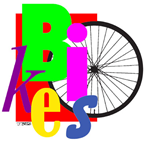Bicycle Channel Updates for 2023
Rick Proctor
Television is a wonderful entertainment and educational tool. Most of us grew up with TV as a common home utility, like hot water, flush toilets, and refrigerators. As TV technology grew, so did the programming options, allowing us a limited choice of stuff to watch if we were available when the program of interest was offered. Were those really the good old days? Then a few recording options came along to let us watch that limited choice of stuff when we wanted. Nowadays we can choose from a huge selection of stuff to watch when we want in high definition from a streaming service without the need to record it first. How convenient is that?
Back in those good old days, there was a program quality problem. You had to choose among programs controlled by the advertisers and entertainment industry of the day – finding anything featuring a bike was impossible. In recent years new options have evolved for home TV where entertainment and education have merged into high quality bike oriented programs about real people doing some really cool stuff, presented in interesting ways.
These days there are several bicycling options to choose from if you have modern cable TV and/or internet streaming to your TV. These options also work on a computer or smartphone, although a full size TV provides a better picture and sound. Here are some popular ones:
- YouTube offers an amazing array of videos made by amateurs and professionals. Try a YouTube search for bicycling and you’ll find a need to get more specific to focus the search results. Bicycle touring provides many interesting hits. There are many “bicycle” channels on YouTube to subscribe to, usually with a free option.
- GCN (Global Cycling Network) is a UK based YouTube channel and website with a global reach covering bike performance, technology, culture, maintenance, and more. Several weekly bike oriented shows cover a wide variety of bike interests. Episodes typically vary in length from a few minutes to about ½ hour.
- GCN+ is a few years old as a subscription service offering new documentaries for those interested in bike history, global adventure travel, performance, and more. Past episodes are maintained in an online library ready for your selection. This is the closest thing yet to a real bicycle channel focused only on the various aspects of bicycling, including race coverage not otherwise available in the USA. There are no commercials on this channel because it is a subscription service. Episodes rarely exceed an hour, although races may last several hours.
- Peacock, a streaming subscription service for a wide variety of entertainment also offers top-tier bike race coverage for the Tour Down Under, Paris-Roubaix, Tour de France, Vuelta e Espana, and more with presenters like Phil Liggett, Bob Roll, Christian Vande Velde, and Chris Horner. This subscription service offers two tiers: a cheap one has commercials, the pricier one has no commercials. There are short highlights programs and full length recordings of live presentations several hours long. The presenters, with pro-peloton experience, add entertaining in-depth commentary of bicycle racing and the regions the races pass through.
Many of the bicycling videos show the outstanding scenery of our planet as seen from our favorite form of transportation. Bicycle touring is an adventurous, economical, and environmentally friendly form of travel – and travel is among the most rewarding experiences we can have. Where we cannot travel physically, we can travel virtually via TV for a taste of life in far off lands we may want to add to our bucket list. A rugged adventure presentation can be fascinating, even if you don’t want to do it. This TV and armchair travel mode offers convenience and opportunities to make informed travel decisions.


